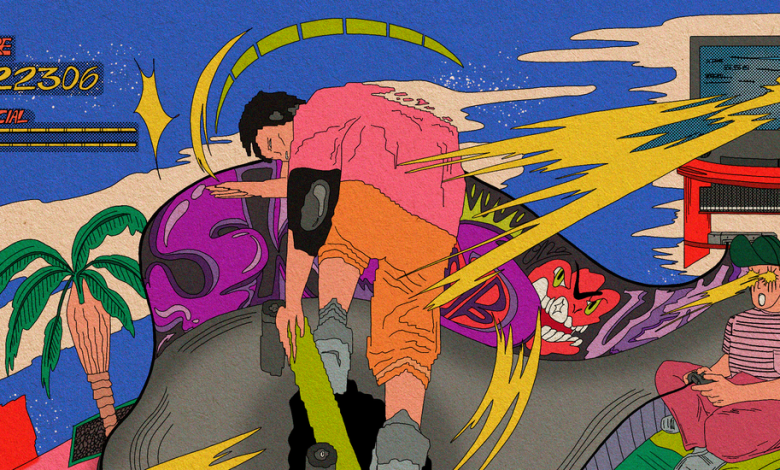Tony Hawk Showed Me What’s Sacred About Cities

Sometimes, when I feel sad, I’ll watch a 2019 video of Tony Hawk cruising down California streets, looking for skaters. When he sees one, he yells, “Do a kick flip!” If they land it, or even if they don’t, he gives them a skateboard deck, or some merch, and maybe a fist bump.
I don’t own a skateboard, and the only place I can do a kick flip is in the 1999 video game “Tony Hawk’s Pro Skater,” but I can still feel a little of the joy of those skateboarders. The premise of the game is simple: You take control of one of a selection of professional skaters like Bob Burnquist, Elissa Steamer or Hawk himself, and try to land a series of increasingly difficult tricks in environments inspired by skating hot spots like Portland’s Burnside Skatepark and San Francisco’s Vaillancourt Fountain. Real-world skaters transformed suburban and urban corners into sporting havens; the Tony Hawk games rendered them as skating fantasy lands.
Released at a moment when skateboarding was beginning to go mainstream, “T.H.P.S.” became popular because it invited skaters and nonskaters alike to feel the thrill of getting air, doing a kick flip or landing a trick by the thinnest margin. Its aesthetic and soundtrack — punk, hip-hop, ska — granted access to a countercultural space that still felt dangerous, not yet totally absorbed into American consumerism.
Growing up in suburban Dublin, I felt an instinctive kinship with American skate culture. After all, skaters had emerged from dull commuter belts of their own and worked together to turn their cities and towns into sites of play. The original games demonstrated an obvious love for that culture — the clothes, the language, the music.
Outside the confines of their digital playgrounds, the game and its sequels carried the promise that my suburbia could be exciting, too. The cheap construction materials and bland, functional architecture that made certain cities and suburbs feel so similar to one another also allowed a kind of cultural affinity. Through beige cladding, concrete stair sets, brushed-chrome railings and rickety plywood ramps, Ventura, Calif., and my own anodyne Leopardstown in Ireland became related, versions of one another thousands of miles apart.
Play “T.H.P.S.” long enough, and you’ll notice your perspective on reality change. My brain instinctively looks for good rails to grind, places I could get air or make a slick transition, even though I’ll most likely never do any of these things. When I was a kid, it made me appreciate the unloved corners of where I came from — the industrial estate, the underground parking lot, the no man’s land beneath a bridge or beside a train station. Video games are full of secret areas, and so is our physical world.
In 2020, the game developer Vicarious Visions released a remastered version of the first two Tony Hawk games. The makers had updated “T.H.P.S.” for modern machines, bolting snazzy new lighting, textures and physics onto the old skeleton. After I came down with Covid in April 2022, I holed up alone in my apartment, and for six days I did little else but virtually skate. To my surprise, I could still flawlessly tail-slide the Venice Ledge, find all the collectible items and win gold at Marseille.
Paradoxically, the remake feels more faithful to the original games than it really is. Instead of replicating how the games were, the developers recreated how I remember them. It’s as if they found my fuzzy memories of their beautiful toy-box skate parks and cities. Watching clips of the Venice Beach level in the original version on YouTube, I saw that the zone was flatly lit, oddly empty, made of wobbly ’90s polygons. With the remake, I see the Southern California of my dreams, a golden playground on the beach, all intricate graffiti and evocative Western architecture.
In real life, skating is an art form that requires constant sacrifice, physical pain and public embarrassment for the sake of an ephemeral few seconds of pure beauty. You have to fall a thousand times before you succeed. The Tony Hawk games aren’t concerned with that. They recreate the iterative satisfaction of skating — the feeling that, with enough practice, you can do something miraculous — without all the concussions, bloody knees and shattered wrists.
The games also remind you of the endless possibilities that cities possess, the antithesis of how we have sometimes been encouraged to approach them: with caution. Skating shows us another path. It allows us to see cities as social spaces, zones of exciting risk. A nondescript, alien piece of concrete can become a hallowed skate spot, a place to meet, take chances and store memories. I’ll probably never learn how to do a kick flip in real life. But when I play “T.H.P.S.,” I let the strains of Goldfinger’s “Superman” wash over me as I spend a few hours inside a fantasy city. I ollie, bail, go again. It makes me look at my home differently. It reminds me of the places out there in the world yet to be discovered, the tricks yet to be attempted and the chance, however faint, of one day landing them.
Jack Sheehan is a writer and historian from Dublin, Ireland.
